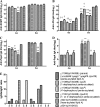Phosphate groups of lipid A are essential for Salmonella enterica serovar Typhimurium virulence and affect innate and adaptive immunity
- PMID: 22753374
- PMCID: PMC3418755
- DOI: 10.1128/IAI.00123-12
Phosphate groups of lipid A are essential for Salmonella enterica serovar Typhimurium virulence and affect innate and adaptive immunity
Abstract
Lipid A is a key component of the outer membrane of Gram-negative bacteria and stimulates proinflammatory responses via the Toll-like receptor 4 (TLR4)-MD2-CD14 pathway. Its endotoxic activity depends on the number and length of acyl chains and its phosphorylation state. In Salmonella enterica serovar Typhimurium, removal of the secondary laurate or myristate chain in lipid A results in bacterial attenuation and growth defects in vitro. However, the roles of the two lipid A phosphate groups in bacterial virulence and immunogenicity remain unknown. Here, we used an S. Typhimurium msbB pagL pagP lpxR mutant, carrying penta-acylated lipid A, as the parent strain to construct a series of mutants synthesizing 1-dephosphorylated, 4'-dephosphorylated, or nonphosphorylated penta-acylated lipid A. Dephosphorylated mutants exhibited increased sensitivity to deoxycholate and showed increased resistance to polymyxin B. Removal of both phosphate groups severely attenuated the mutants when administered orally to BALB/c mice, but the mutants colonized the lymphatic tissues and were sufficiently immunogenic to protect the host from challenge with wild-type S. Typhimurium. Mice receiving S. Typhimurium with 1-dephosphorylated or nonphosphorylated penta-acylated lipid A exhibited reduced levels of cytokines. Attenuated and dephosphorylated Salmonella vaccines were able to induce adaptive immunity against heterologous (PspA of Streptococcus pneumoniae) and homologous antigens (lipopolysaccharide [LPS] and outer membrane proteins [OMPs]).
Figures




Similar articles
-
Palmitoylation state impacts induction of innate and acquired immunity by the Salmonella enterica serovar typhimurium msbB mutant.Infect Immun. 2011 Dec;79(12):5027-38. doi: 10.1128/IAI.05524-11. Epub 2011 Sep 19. Infect Immun. 2011. PMID: 21930761 Free PMC article.
-
Effect of deletion of genes involved in lipopolysaccharide core and O-antigen synthesis on virulence and immunogenicity of Salmonella enterica serovar typhimurium.Infect Immun. 2011 Oct;79(10):4227-39. doi: 10.1128/IAI.05398-11. Epub 2011 Jul 18. Infect Immun. 2011. PMID: 21768282 Free PMC article.
-
Protective Immunity Elicited by Oral Immunization of Mice with Salmonella enterica Serovar Typhimurium Braun Lipoprotein (Lpp) and Acetyltransferase (MsbB) Mutants.Front Cell Infect Microbiol. 2016 Nov 10;6:148. doi: 10.3389/fcimb.2016.00148. eCollection 2016. Front Cell Infect Microbiol. 2016. PMID: 27891321 Free PMC article.
-
Evasion of host immunity by virulent Salmonella: implications for vaccine design.Curr Med Chem. 2011;18(36):5666-75. doi: 10.2174/092986711798347333. Curr Med Chem. 2011. PMID: 22172071 Review.
-
Live Attenuated Human Salmonella Vaccine Candidates: Tracking the Pathogen in Natural Infection and Stimulation of Host Immunity.EcoSal Plus. 2016 Nov;7(1):10.1128/ecosalplus.ESP-0010-2016. doi: 10.1128/ecosalplus.ESP-0010-2016. EcoSal Plus. 2016. PMID: 27809955 Free PMC article. Review.
Cited by
-
Fortifying the barrier: the impact of lipid A remodelling on bacterial pathogenesis.Nat Rev Microbiol. 2013 Jul;11(7):467-81. doi: 10.1038/nrmicro3047. Epub 2013 Jun 10. Nat Rev Microbiol. 2013. PMID: 23748343 Free PMC article. Review.
-
New technologies in developing recombinant attenuated Salmonella vaccine vectors.Microb Pathog. 2013 May;58:17-28. doi: 10.1016/j.micpath.2012.10.006. Epub 2012 Nov 8. Microb Pathog. 2013. PMID: 23142647 Free PMC article. Review.
-
High-throughput living cell-based optical biosensor for detection of bacterial lipopolysaccharide (LPS) using a red fluorescent protein reporter system.Sci Rep. 2016 Nov 14;6:36987. doi: 10.1038/srep36987. Sci Rep. 2016. PMID: 27841364 Free PMC article.
-
Gut Microbiome-Based Analysis of Lipid A Biosynthesis in Individuals with Autism Spectrum Disorder: An In Silico Evaluation.Nutrients. 2021 Feb 21;13(2):688. doi: 10.3390/nu13020688. Nutrients. 2021. PMID: 33669978 Free PMC article.
-
Phylogenetic barriers to horizontal transfer of antimicrobial peptide resistance genes in the human gut microbiota.Nat Microbiol. 2019 Mar;4(3):447-458. doi: 10.1038/s41564-018-0313-5. Epub 2018 Dec 17. Nat Microbiol. 2019. PMID: 30559406 Free PMC article.
References
-
- Bainbridge BW, Darveau RP. 2001. Porphyromonas gingivalis lipopolysaccharide: an unusual pattern recognition receptor ligand for the innate host defense system. Acta Odontol. Scand. 59:131–138 - PubMed
-
- Bhat UR, Forsberg LS, Carlson RW. 1994. Structure of lipid A component of Rhizobium Leguminosarum bv Phaseoli lipopolysaccharide—unique nonphosphorylated lipid A containing 2-amino-8-deoxygluconate, galacturonate, and glucosamine. J. Biol. Chem. 269:14402–14410 - PubMed
-
- Bligh EG, Dyer WJ. 1959. A rapid method of total lipid extraction and purification. Can. J. Biochem. Phys. 37:911–917 - PubMed
Publication types
MeSH terms
Substances
Grants and funding
LinkOut - more resources
Full Text Sources
Other Literature Sources
Medical
Research Materials

